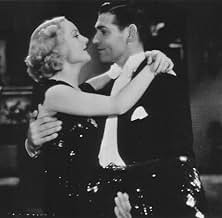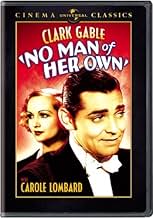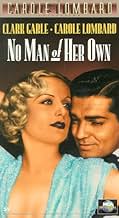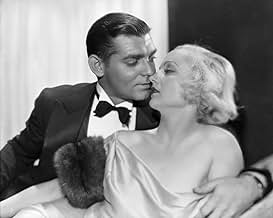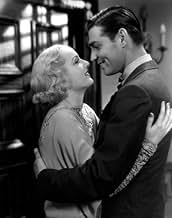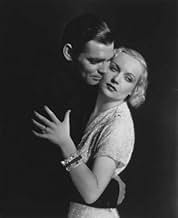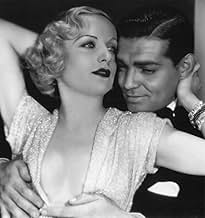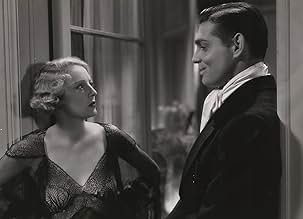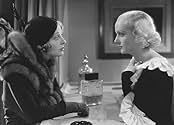NOTE IMDb
6,6/10
1,8 k
MA NOTE
Ajouter une intrigue dans votre langueAn on-the-lam New York card shark marries a small-town librarian who thinks he's a businessman.An on-the-lam New York card shark marries a small-town librarian who thinks he's a businessman.An on-the-lam New York card shark marries a small-town librarian who thinks he's a businessman.
- Réalisation
- Scénario
- Casting principal
- Récompenses
- 1 victoire au total
Sammy Blum
- Door to Door Salesman
- (non crédité)
Mary Bracken
- High School Girl
- (non crédité)
Wallis Clark
- Thomas Laidlaw
- (non crédité)
Lillian Harmer
- Mattie
- (non crédité)
Margaret Marquis
- Girl in the Library
- (non crédité)
Avis à la une
No Man of Her Own is a pleasant film, nothing terribly bad or terribly good about it. It is remembered today as the only pairing of that star-crossed couple Clark Gable and Carole Lombard. At the time this was made Gable and Lombard were not an item. They became one about four or five years after No Man of Her Own was filmed. It's not on the top 10 list of either star.
Gable is a gambler/con artist who's forced by circumstance to beat it out of New York and he flees for a small suburb where he meets librarian Carole Lombard and marries her. That's as far as I'm going with the telling of the plot.
Lombard was with Paramount at the time this was made and Gable was on loan out from MGM. There's none of the Lombard we knew and loved in such classics as Twentieth Century or My Man Godfrey here. She's a pleasant enough screen heroine though. Gable does well in his part, but doesn't set the world on fire.
If someone had only predicted that Gable and Lombard and their marriage would be come legendary. I'm sure they would have been given a much better film property. I always felt that if Lombard had not been killed in that plane crash in 1942 she would have eventually signed with MGM and L.B. Mayer would have paired her with Gable in the way Katharine Hepburn signed with MGM after the success of Woman of the Year with Spencer Tracy. You might have had a few films to remember Gable and Lombard by.
Gable is a gambler/con artist who's forced by circumstance to beat it out of New York and he flees for a small suburb where he meets librarian Carole Lombard and marries her. That's as far as I'm going with the telling of the plot.
Lombard was with Paramount at the time this was made and Gable was on loan out from MGM. There's none of the Lombard we knew and loved in such classics as Twentieth Century or My Man Godfrey here. She's a pleasant enough screen heroine though. Gable does well in his part, but doesn't set the world on fire.
If someone had only predicted that Gable and Lombard and their marriage would be come legendary. I'm sure they would have been given a much better film property. I always felt that if Lombard had not been killed in that plane crash in 1942 she would have eventually signed with MGM and L.B. Mayer would have paired her with Gable in the way Katharine Hepburn signed with MGM after the success of Woman of the Year with Spencer Tracy. You might have had a few films to remember Gable and Lombard by.
... and I could definitely feel the chemistry between Lombard and Gable, even if they could not at this point. But it is a rather understated affair, even dragging at times.
It starts out lively and with promise, as a group of four card sharps make a killing against a mark and divide their loot. But afterwards a cop, Collins, comes up to speak to the ringleader, Jerry Stewart (Clark Gable), and lets him know he's on to what he's doing and is watching him. Also that same night, Jerry breaks up with one of his fellow card sharps, Kay (Dorothy Mackail), and she threatens to go to the DA about their activities in retaliation. Jerry decides to leave town for awhile until the immediate heat is off and travels to the tiny hamlet of Glendale. There he meets somebody who is as bored with the place as he is, town librarian Connie Randall (Carole Lombard). Things heat up quickly between them and they impulsively marry. Jerry never told Connie what he really does for a living, letting her believe he is a stockbroker. But being a gambler is all he knows, so what now, once they are back in New York? Complications ensue.
This is not a screwball comedy with Lombard doing her trademark screwball comedienne act. Lombard is a dramatic actress at this point, and doesn't really begin to hone her comedic chops until "Twentieth Century" in 1934. Gable is the one mainly carrying any comedic weight in this film, which is something he always did well.
I'd mildly recommend it mainly to see the only screen pairing of Lombard and Gable, years before they had any romantic interest in one another.
It starts out lively and with promise, as a group of four card sharps make a killing against a mark and divide their loot. But afterwards a cop, Collins, comes up to speak to the ringleader, Jerry Stewart (Clark Gable), and lets him know he's on to what he's doing and is watching him. Also that same night, Jerry breaks up with one of his fellow card sharps, Kay (Dorothy Mackail), and she threatens to go to the DA about their activities in retaliation. Jerry decides to leave town for awhile until the immediate heat is off and travels to the tiny hamlet of Glendale. There he meets somebody who is as bored with the place as he is, town librarian Connie Randall (Carole Lombard). Things heat up quickly between them and they impulsively marry. Jerry never told Connie what he really does for a living, letting her believe he is a stockbroker. But being a gambler is all he knows, so what now, once they are back in New York? Complications ensue.
This is not a screwball comedy with Lombard doing her trademark screwball comedienne act. Lombard is a dramatic actress at this point, and doesn't really begin to hone her comedic chops until "Twentieth Century" in 1934. Gable is the one mainly carrying any comedic weight in this film, which is something he always did well.
I'd mildly recommend it mainly to see the only screen pairing of Lombard and Gable, years before they had any romantic interest in one another.
10lora64
This is a pleasant kind of tale, easygoing and amusing. Clark Gable as the gambler Babe Stewart, meets quiet (i.e. repressed) librarian Connie Randall, played by Carole Lombard. At the library, when he corners her amongst the bookshelves, she asks, "Do you like Shakespeare?" and I like Gable's reply, "Oh Shakespeare's alright but sometimes you just don't feel like Shakespeare" says he gazing deep into her eyes. Just an amusing moment.
After a hesitant start they inevitably fall in love and impulsively decide to wed, and thereafter the plot unfolds. Gable resumes his dishonest card sniping activities (i.e. racket), however this clashes with the wifey on the domestic front. In time he plans to reform his ways, "Things gotta be different from now on," he tells the police, but there are complications ahead.
It's very interesting to see a younger Clark Gable who even at this stage was well established in his screen presence. And Carole Lombard couldn't be more beautiful! Great viewing for the fans of Gable and Lombard.
After a hesitant start they inevitably fall in love and impulsively decide to wed, and thereafter the plot unfolds. Gable resumes his dishonest card sniping activities (i.e. racket), however this clashes with the wifey on the domestic front. In time he plans to reform his ways, "Things gotta be different from now on," he tells the police, but there are complications ahead.
It's very interesting to see a younger Clark Gable who even at this stage was well established in his screen presence. And Carole Lombard couldn't be more beautiful! Great viewing for the fans of Gable and Lombard.
I think other reviewers heard that this was supposed to be "a screwball comedy" and ran with that idea because they didn't know what else to say. I didn't see anything light and fluffy or "screwball" about it. Perhaps "offbeat" might be a more apt characterization. Gable's interpretation of the New York gambler was interesting because something in his usual sort of charming yet manly approach was notably lacking. He possessed the irreverent and utterly confident attitude we have come to associate with his other performances, but a number of his youthful facial expressions were of a more complex and unfamiliar sort. The reserved yet knowing way he nodded howdy-do upon introduction to Lombard's mother and then her father was especially amusing, I thought. There were also the many intriguing interactions with the actress, herself, particularly with regard to the touchy subjects of marriage and stability. The oft-subtle writing in this flick made for several interesting moments and both actors were fully up to the challenge of a sensitive and intelligent interpretation of the script. It is also interesting that there was allegedly no actual romantic attachment between these two because the chemistry was already quite evident. It must have miffed a number of the more glamorous Hollywood starlets when Lombard won Gable's heart in real life. Although beautiful, she wasn't glamorous, nor was she pretentious and affected, but more like the girl next door. I read that the library scene (where Gable sent her up a ladder as an excuse to examine her legs) single-handedly started some sort of decency league in the motion picture industry. The bluenoses are always with us, aren't they, shoving their childish attitudes down the throats of the adults. Much more risqué was the scene in which Lombard's predecessor, Kay, appeared on screen in a see-through nightgown that revealed critical aspects of her anatomy, both front and back. The thirties obviously were a much less prudish time because her gentlemen friends didn't even pay much attention, at least not overtly, and scenes such as that would not appear in movies again until the sixties. We've noted a similar sensuality in other movies from that era. As a society, we keep coming back to the cultural doldrums, where they are pushing wealth or war or something else that always seems to further the interests of those in control. Unconventional times like the thirties and the sixties are few and far between. It showed in this movie.
Clark Gable and his great love, Carole Lombard, only made one film together - this one, "No Man of Her Own" - and they weren't even a couple. At the time of "No Man of Her Own," Lombard was married to William Powell, and Gable to a socialite named Maria Franklin. When he fell for Lombard a few years after this movie was made, it was some time before Franklin would give him a divorce.
A mustacheless Gable plays a cheating card shark who, while on the lam, meets a librarian (Lombard) and marries her. He's not planning that it be permanent; along the way, they fall in love.
Both stars are very good and have great chemistry. She's beautiful, and he's just one sexy devil with that smile and the way he looked at a woman. Pretty devastating, with or without the mustache. A great screen presence.
Someone commented that had Lombard not died, she would have signed with MGM and been paired with Gable in more films. It would be wonderful to have them together more than once. In 1937, in fact, when Jean Harlow died during the making of "Saratoga," Gable recommended that she be replaced with Lombard. Lest anyone think that was insensitive - the situation of a star dying in the middle of a film was new to everyone, no one knew how it would be handled, and poor Gable thought he was helping. People back then didn't think in terms of leaving a legacy and last films.
So we're stuck with the pre-code "No Man of Her Own." Not bad, not great, of interest because of its two stars.
A mustacheless Gable plays a cheating card shark who, while on the lam, meets a librarian (Lombard) and marries her. He's not planning that it be permanent; along the way, they fall in love.
Both stars are very good and have great chemistry. She's beautiful, and he's just one sexy devil with that smile and the way he looked at a woman. Pretty devastating, with or without the mustache. A great screen presence.
Someone commented that had Lombard not died, she would have signed with MGM and been paired with Gable in more films. It would be wonderful to have them together more than once. In 1937, in fact, when Jean Harlow died during the making of "Saratoga," Gable recommended that she be replaced with Lombard. Lest anyone think that was insensitive - the situation of a star dying in the middle of a film was new to everyone, no one knew how it would be handled, and poor Gable thought he was helping. People back then didn't think in terms of leaving a legacy and last films.
So we're stuck with the pre-code "No Man of Her Own." Not bad, not great, of interest because of its two stars.
Le saviez-vous
- AnecdotesAlthough Carole Lombard and Clark Gable later became one of Hollywood's most famous couples, they were completely indifferent to one another during the making of this film. It was not until several years later that they met again and fell in love and got married. This was Gable and Lombard's only film together.
- GaffesEarly in the movie, Babe takes a taxi; there is a very clear view of the front hood of the cab, with the telephone number of the cab company. Later in the movie, Babe calls his wife with his new office phone number. He looks at the dial of his new phone and gives her the telephone number of the cab company.
- Crédits fousThe cast is shown on a hand of poker cards, with the leads' faces shown as the various cards.
- ConnexionsFeatured in The Love Goddesses (1965)
Meilleurs choix
Connectez-vous pour évaluer et suivre la liste de favoris afin de recevoir des recommandations personnalisées
- How long is No Man of Her Own?Alimenté par Alexa
Détails
- Date de sortie
- Pays d’origine
- Langue
- Aussi connu sous le nom de
- No Man of Her Own
- Lieux de tournage
- Société de production
- Voir plus de crédits d'entreprise sur IMDbPro
- Durée1 heure 25 minutes
- Couleur
- Rapport de forme
- 1.37 : 1
Contribuer à cette page
Suggérer une modification ou ajouter du contenu manquant

Lacune principale
By what name was Un mauvais garçon (1932) officially released in India in English?
Répondre
